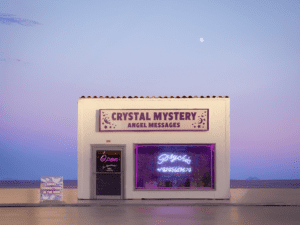Photography has never stopped evolving. From the invention of the camera in the early 19th century to digitisation and today’s smartphones, it has long been used to document the many different faces of humanity. This season, exhibitions around the world are championing practitioners who revolutionised 20th century imagery through new approaches to the medium. Here, audiences can witness work by Bruno Barbey, who captured the impact of international conflicts; Claude Cahun’s early experimental compositions exploring identity; and monochrome shots of nomadic communities by Tina Modotti.

Bruno Barbey: Always on the Move | National Museum, Warsaw | Until 3 March
“I seldom stay still. I walk around, always on the move,” said Bruno Barbey, (1941–2020) whose images document the impact of different conflicts across globe. During his five-decades-long career, he travelled to Cambodia, Bangladesh, Brazil, Nigeria, Northern Ireland and Vietnam. Now, a solo exhibition at the National Museum in Warsaw is dedicated to his observations of humanity. Besides Barbey’s well-known shots, the display features photos reflecting the reality of Poland and Ukraine in the 1980s. They would later be published in a report which helped win independence and liberation from the USSR. These works continue to stay relevant in the context of the ongoing war across Eastern Europe. What’s striking is the intense hues and colour combinations – a signature of Barbey’s timeless approach to picture-making.

Claude Cahun: Beneath This Mask | Djanogly Gallery, Nottingham | Until 17 March
This touring exhibition – originally commissioned by London’s Hayward Gallery – explores the work of French photographer Claude Cahun (1894-1954), whose practice was deeply engaged with the politics of identity. Born Lucy Schwob, she adopted Cahun as a pseudonym in 1917 to free herself from the confines of 20th century gender norms. At the start of her career, she was aligned with the Surrealist movement; her friends included André Breton. She would later distance herself from the group after fleeing France, settling in Jersey where she embarked upon her landmark series of images. Cahun’s most pressing concerns were to subvert traditional portraiture and to highlight the construction of gender. She achieved posthumous fame for her elusive self-portraits in which she assumed multiple personae and stares at the camera. Beneath This Mask contains 42 contemporary giclee prints made from scans of Cahun’s original work.

Saul Leiter: An Unfinished World | MK Gallery, Milton Keynes | Until 2 June
American photographer Saul Leiter (1923–2013) is one of the most important practitioners of the post-war period. He is celebrated for his iconic images of New York City in the 1950s and 1960s, and, for nearly 60 years, he documented daily life and the mundane beauty of the metropolis. Throughout his career, he amassed a remarkable collection of around 15,000 monochrome prints, 40,000 colour slides and over 4,000 paintings. MK Gallery hosts the largest UK presentation of Leiter’s work to date. Viewers can explore over 170 photographs, many of which exemplify his hallmark painterly style. Raindrops, reflected light and smudges are synonymous with Leiter; this show makes sure his legacy continues.

Tina Modotti: The Eye of Revolution | Jeu de Paume, Paris | Until 12 May
Paris’ Jeu de Paume pays tribute to Tina Modotti (1896-1942) through a major new exhibition. The photographer and political activist produced her most well-known works between 1923 and 1930, during which time her life was shaped by a nomadic spirit and passion for justice. It took her to countries like Germany, Spain, Switzerland and Russia, where she made pictures striking in their intensity. One of her most notable trips was spent in Mexico, during which she documented activists and fellow artists including Frida Kahlo and Diego Rivera. The Eye of Revolution brings together 240 prints as well as archival documents and magazines. It retraces Modotti’s career and provides her view from behind the camera.

Irving Penn | de Young, San Francisco | From 16 March
Irving Penn (1917-2019) is listed amongst the 20th century’s greatest photographers and is renowned for his pared-down aesthetic. As Vogue’s longest-standing contributor, he revolutionised fashion photography in the post-war period by using neutral backgrounds and focusing on the models’ gestures and expressions. Penn is best-known for his portraiture, although he created a wide range of works including prints and still lifes. Organised by The Metropolitan Museum of Art, de Young’s show walks us through every period of the artist’s seven-decades-long career. The display includes a selection of archival material; over 190 monochrome and full-colour photographs; mid-century fashion magazines; and a dedicated series made in San Francisco during the “Summer of Love” in 1967.
Image credits:
1. Bruno Barbey Meknes. Moulay Ismael Mausoleum (Muslim shrine). Morocco. 1985. © Bruno Barbey | Magnum Photos
2. Bruno Barbey Women resting along the ramparts. Essaouira. Morocco. 1987. © Bruno Barbey | Magnum Photos
3. Claude Cahun, Untitled, c.1928. © and Courtesy Jersey Heritage
4. Saul Leiter. Courtesy of Steidl.
5. Tina Modotti Zapotec peasant woman with a jug on her shoulder, 1926 Platinotype, period print 17,5 × 21,2 cm Collection and archives of the Fundación Televisa, Mexico
6. After-Dinner Games, New York, 1947, printed 2003Chromogenic printFramed: 30 3/4 x 25 3/4 x 1 3/8 in. (78.105 x 65.405 x 3.493cm)Image: 30 x 24 1/2 in. (76.2 x 62.23 cm)The Irving Penn Foundation





